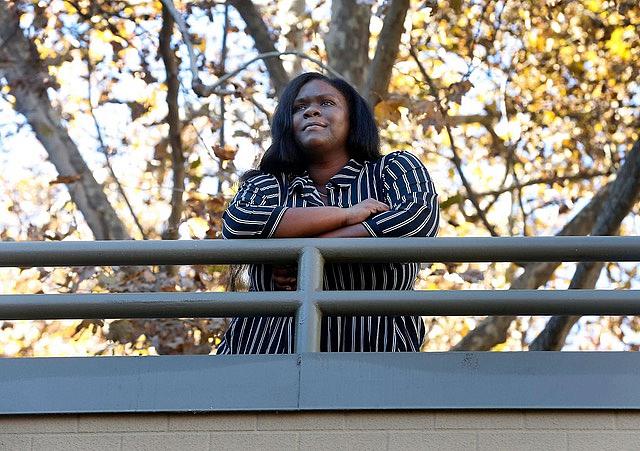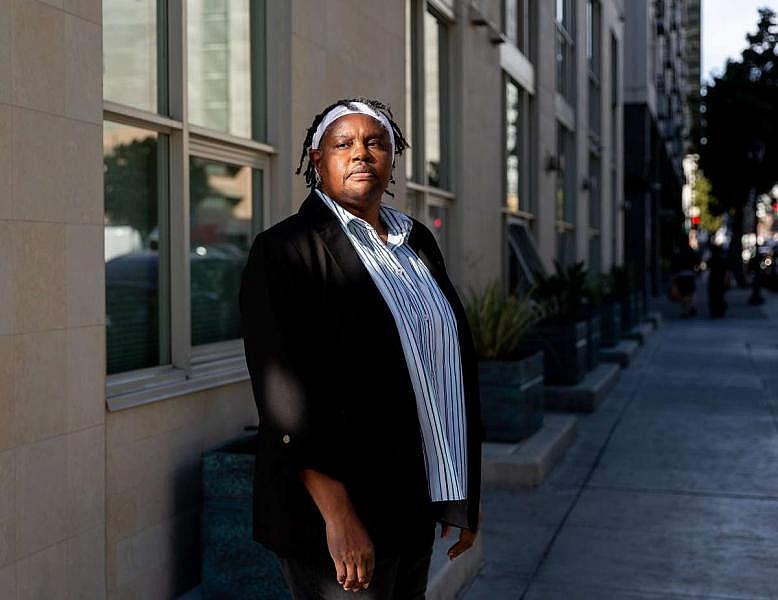After abuse reports, California approves $8 million for youth returning from troubled treatment programs
This story is part of a larger project by The San Francisco Chronicle and The Imprint. Reporter Cynthia Dizikes was a participant in the 2019 Data Fellowship, a program of the Center for Health Journalism at the University of Southern California’s Annenberg School for Communication and Journalism.
Other stories in this series include:
Amid abuse reports, Sequel-run facility that treated California children will close
After abuse probe, another Sequel-run program that housed California youth will close

DaeJah Seward is seen outside her place of work in Sacramento, Calif. on Tuesday, Nov. 24, 2020.
Paul Chinn / The Chronicle 2020
But despite a fast-approaching deadline of Jan. 23 to bring the children home, 64 youths remained in these faraway programs last week, even though officials deemed them unsafe more than a month ago.
County child welfare and probation officials say they are working as fast as possible to bring the children back to California, but some have challenging mental and behavioral health needs that make treatment difficult. Arranging travel during the pandemic has also posed logistical challenges.
“I have my fingers crossed, because we have placements lined up for these youth,” said Ron Miller, chief probation officer in Riverside County, which has three youths still at out-of-state programs and is making arrangements to get them home by next week.
California leaders moved to cut ties with out-of-state treatment facilities in early December, when reporters for The Chronicle and The Imprint shared the findings of their investigation with state officials. That report, “Far from Home, Far from Safe,” detailed how California had for years sent children to treatment centers run by a for-profit company, Sequel Youth & Family Services, despite state laws that forbid sending youth to for-profit residential programs.
Children at these facilities — many of whom had been charged with crimes, abused or abandoned — suffered bruises and broken bones at the hands of staff. Reporters found that the California Department of Social Services had long known about this abuse: Records showed that since 2017, child welfare officials in California and other states investigated hundreds of alleged violations or deficiencies at Sequel facilities, including complaints that staff members hit, kicked or sexually assaulted residents and placed them in unauthorized and dangerous restraints.
Yet California continued to send children to Sequel-run programs, shipping more than 1,240 young people to facilities in Michigan, Iowa, Wyoming, Arizona and Utah since 2015 — roughly half of all foster youth sent out of state.
Sequel representatives told reporters in November that they take allegations of abuse seriously. In a statement, they said they have increased staff training and will end their practice of physically restraining children.
Child welfare officials, youth advocates and former residents applauded the money that California is now providing to local governments, but some said the one-time funds fall short of what is needed to care for the state’s most vulnerable children. Many of the boys and girls sent out of state grapple with drug addiction, trauma and mental illness on top of abuses they may have experienced or witnessed in treatment programs.
"I Am" by Alka Writes. Acrylic on Canvas.
“The additional funding will help, but it’s a stopgap to a larger issue we need to deal with,” said Chris Stoner-Mertz, CEO of the California Alliance of Child and Family Services, which represents treatment programs and youth service providers. “We’re going to need to think long-term about what it takes, from a funding standpoint, to truly serve all youth in-state.”
Youth advocates had for years been pushing state leaders to cut ties with out-of-state programs, saying they hurt traumatized children more than they help them. Maria Ramiu, a senior staff attorney at the Youth Law Center in San Francisco, said the extra dollars could help counties treat young people more effectively through in-home services or at residential placements near their families and communities — not thousands of miles away.
“It is something that should have happened a lot sooner,” Ramiu said. “The things that are happening to the young people that are being brought back should provide a road map for what should happen for other youth.”
The state social services agency said it began a review of its certified out-of-state programs after staff at the Sequel-run Lakeside Academy in Michigan killed a boy during an improper restraint in May. Agency officials said they found every program “lacking”: Staff members intimidated and demeaned residents, failed to get children prompt medical attention and used “excessive force” during hands-on restraints that caused bruises or injuries, according to letters the department sent to the facilities last month.
On Dec. 10, Gov. Gavin Newsom’s administration notified the Joint Legislative Budget Committee of “unanticipated costs related to the return of foster youth from out-of-state facilities,” according to a Department of Finance spokesperson. Six days later, the committee agreed to a one-time allocation of $5.2 million for the California Department of Social Services and an additional $2.9 million for the Department of Developmental Services.
The funds for the Department of Social Services, which must be spent by June 30, are intended to help counties quarantine the children as they return to California amid the pandemic, and to secure homes and treatment plans for them. Counties may need to create new programs to care for children who require around-the-clock, one-on-one supervision, said Stoner-Mertz, adding that many questions remain.
“There are youth who are sexually exploited minors who may be at risk of leaving a facility and trying to go to their exploiter,” she said. “How do you both staff and provide the specialized service needed to address that young person’s needs and keep them safe?”
Coronavirus Map: Tracking COVID-19 cases across the Bay Area and California.
The $2.9 million earmarked for the Department of Developmental Services will target the roughly 10 returning youths who have developmental disabilities. In addition to these emergency funds, the governor has requested another $5.8 million from the Legislature for these young people.
While the millions in extra financial support will help the children coming back to California in the weeks ahead, bolstering local programs will require a long-term commitment that California has not yet made, county officials said.
Probation and child welfare authorities prefer in-state programs because licensing officials can more easily monitor them, while children can remain closer to their families and communities. Many youth who were sent out of state, however, had been turned away from local programs for running away or acting out. Some had been charged with serious crimes and required intensive treatment not available in California.
“We have appreciated the state’s commitment to partnership in addressing these issues,” said Rosie McCool, deputy director of the Chief Probation Officers of California. “But we know this one-time funding will not be sufficient to invest in long-term solutions.”
The children with the greatest needs will take the longest to bring home, said Cathy Senderling-McDonald, deputy executive director of the County Welfare Directors Association of California.
Officials in San Diego County said they were working with the state Department of Social Services to find a home for one teenager who remained out of state as of Wednesday. Officials with other counties said the pandemic had made it more difficult to find treatment programs in California, as some facilities have barred new admissions.
Without a more consistent funding stream and wider reforms, the recent allocations will be like “putting a Band-Aid on a bullet wound,” said DaeJah Seward, a 24-year-old who was sent to a Sequel facility in 2012 and now works with foster youth at a Sacramento law firm. “I think that they can do way better than this.”
Joaquin Palomino and Cynthia Dizikes are San Francisco Chronicle staff writers, and Sara Tiano is a staff writer for The Imprint. Email: jpalomino@sfchronicle.com, cdizikes@sfchronicle.com, stiano@imprintnews.org
[This story was originally published by the SF Chronicle.]

